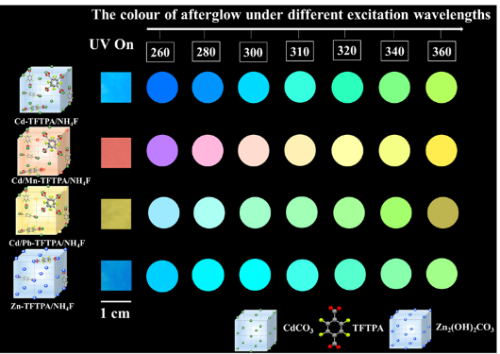Room-Temperature Phosphorescent Organic-Doped Inorganic Frameworks Showing Wide-Range and Multicolor Long-Persistent Luminescence
Long-persistent luminescent systems have attracted great attention due to their effective utilization of the excited state energy and long-lived photoemission. Long-persistent luminescence is typically achieved using pure inorganic materials; however, their relatively high cost, low flexibility and complex methods have restricted their large-scale applications to some extent. The persistent luminescence of purely organic materials is generally less efficient due to their poor intersystem crossing (ISC) ability and their rapid rate of non-radiative deactivation caused by the molecular motions, including rotation, vibration and collision. In recent years, an extensive collection of organic persistent phosphors with ultra-long room temperature phosphorescence (URTP) has been developed utilizing different design strategies.
Despite the continuous development of URTP systems, achieving a tunable and multi-color emission is still a challenge, particularly for those simultaneously tuning the static and dynamic afterglow performance based on a single chromophore. Owing to the advantageous characteristics of the inorganic solid-state framework, including its high rigidity and stability, together with the tuning variability of organic RTP molecules, they hypothesize that if the organic RTP phosphor guest can be doped into the inorganic host, the molecular motions and vibrations can be highly restricted, which would further suppress the nonradiative loss of triplet excitons and facilitate the RTP output. Moreover, the RTP could be further tuned based on both host-guest interactions, variable molecular aggregation and the external doping of inorganic ions. Therefore, Yan’s group put forward a new route of organics doped inorganic frameworks to achieve wide-range and multi-colorful ultra-long RTP. Notably, this strategy has also been proven to be universal as well.
With the advantages of diverse molecular aggregations with multi-central luminescence,the in-situ doping of organic phosphor (tetrafluoroterephthalic acid (TFTPA)) into host matrix (CdCO3) exhibits an excitation-dependent colorful RTP Compared to the pristine organic phosphor (TFTPA), the RTP lifetime of the doped organic/inorganic hybrids is greatly enhanced (313 folders). Also, the RTP quantum yield could reach to 43.9%, which is much higher than that of the pristine TFTPA, and also among the high level for the current RTP materials. Moreover, the hybrid RTP materials (co-doped Mn2+ and Pb2+) show a novel time-resolved tunable afterglow emission, and the excitation-dependent RTP color from dark-blue to red, covering nearly the whole visible spectrum and outperforming the state-of-the-art RTP materials.
Therefore, this work not only describes a combined co-doping and multi-central strategy to obtain statically and dynamically tunable long-persistent afterglow, but also provides great opportunity for the use of organic-inorganic hybrids materials in multi-level anti-counterfeiting and multi-color display applications. Combination of both fundamental study and application on the new type of molecule-based afterglow, they believe this work would arouse a broad interest from readership in materials, chemistry and information science fields.
“Room-Temperature Phosphorescent Organics Doped Inorganic Frameworks Showing Wide-Range and Multi-Colorful Long-Persistent Luminescence” was supported by the National Natural Science Foundation of China (Grant No. 21771021, 21822501 and 22061130206), the Beijing Municipal Natural Science Fundation (Grant No. JQ20003), the Newton Advanced Fellowship award (NAFR1285), the Fok Ying-Tong Education Foundation (Grant No. 171008), the Beijing Nova Program (Grant No. xx2018115), the Measurements Fund of Beijing Normal University, and the Fundamental Research Funds for the Central Universities. Graduate student Guowei Xiao of Yan’s research group, served as the paper’s first authors.
The study was published (09 Apr 2021) in Research, the first Science Partner Journal recently launched by the American Association for the Advancement of Science (AAAS) in collaboration with the China Association for Science and Technology (CAST). Yan is a professor of Beijing Key Laboratory of Energy Conversion and Storage Materials, College of Chemistry Beijing Normal University.
Tag: Advanced Materials
Source: https://spj.sciencemag.org/journals/research/2021/9862327/

